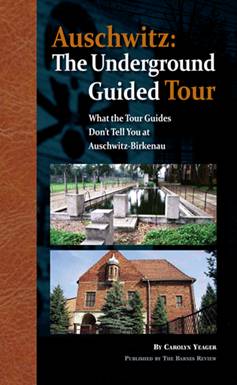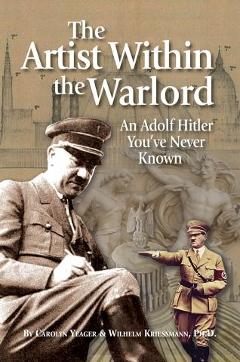70 years ago, one third of Pforzheim's population perished in 16 minutes
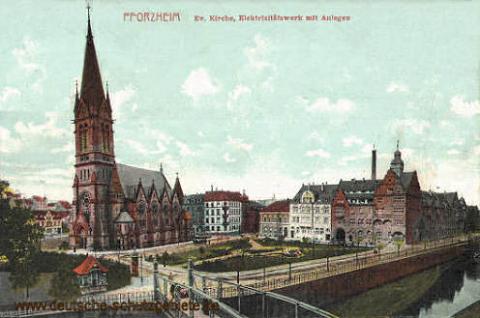
Old Pforzheim church and market square with monument of Bismarck.
On February 23, 1945, the Royal Air Force attacked the mid-size city of Pforzheim in Baden, in southwestern Germany, for the last time--the previous times being six night raids in Oct. 1944 and one in November. They didn't need to do it again because this attack by 378 aircraft, all but 10 of them heavy bombers, dropped 730 tons of explosives and 820 tons of incendiary bombs and set off the intended firestorm that consumed every building of the town center.
Nearly sixty thousand people were in the town that night. 17,600 of them - one out of three Pforzheimers - were officialy counted as dead and thousands were injured.
The post-war British Bombing Survey Unit boasted that the bombing destruction of Pforzheim was "probably the greatest proportion [percentage] in one raid during the war.” It was considered a complete and resounding success at the time. Yet even after such a complete success by the British, the US Air Force on March 4th bombed the area around the Kupferhammer (main hotel and square), the pilots flying low and opening fire on crowds of civilian survivors, murdering 100 or more. They didn't get around to bombing the railway facilities and destroying the autobahn until March 14, 16, 18, 20 and 24th.
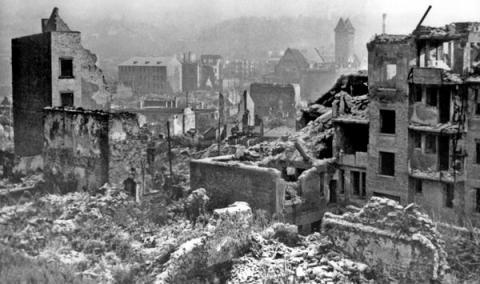
After the firestorm, only smoking ruins.
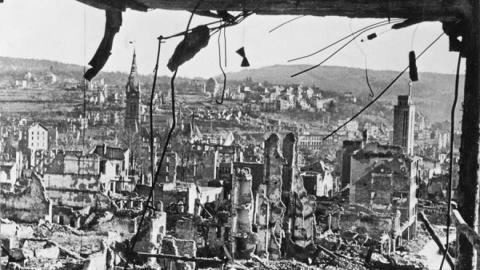
View from the Industrial House south toward the inner city, 1945.
Why? According to the offical British attack command, the goal was "destruction of the built-up urban area, and fitting industrial and railway facilities." Being a clock and watch-making center (cuckoo clocks were a specialty), the British reasoned that the production of precision instruments of use in the war industry was likely taking place "in almost every house in this town." An Allied report issued in August 1944 stated that "almost every house in this town centre is a small workshop." Therefore, when the attack began the first 24 Lancasters dropped air mines and explosive bombs that covered the roofs of the houses.
Was it true about the home workshops? No, it was actually a rumour based on a faulty RAF bomber command report of June 1944 that the British continued to exaggerate. Pforzheim and it's inhabitants seem to have been incinerated for no other reason than to perfect the firestorm capabilities of the RAF.
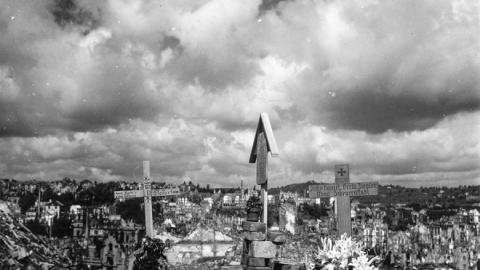
Gravesite crosses above shattered Pforzheim, taken in 1946.
From the townspeople's standpoint
Pforzheim had been downgraded on the British destination lists in May 1944 from a #2 Priority to a #3. There were more important targets, such as hydro-works, aircraft factories, U-boat bases and transportation facilities in Eastern Germany to support the advance of the Red Army. There was none of this in Pforzheim. Yet, at 19.53 hours on Feb. 23, only 8 seconds after the air raid sirens began to scream, the Lancasters arrived in the first of three waves, with 2 minute intervals. At 20.10 the last bomb had been dropped, including the single straight four-pound incendiary sets with a mix of light metal powders that sparked more than 400,000 small fires.
The flames ate their way through the medieval half-timbered houses of the town center. The city's inhabitants were mainly in improvised shelters as there were no bunkers in Pforzheim. The inhabitants had about 20 partially completed tunnels and 70 public air raid shelters in addition to the cellars in public buildings.
From http://www.exulanten.com/pforz.html
In an area about 3 kilometers long and 1.5 kilometers wide, all buildings were reduced to rubble. 17,600 citizens, or one out of three Pforzheimers, were officially counted as dead and thousands were injured. Some died instantly from the impact of explosions, many from burns due to the hellish burning phosphorus that seeped into the cellars of houses where they hid, and others suffocated from lack of oxygen and poisonous gases or were crushed to death by collapsing walls.
Many drowned in the river Enz into which they had jumped, trying in vain to escape from the burning materials in the streets, but even the rivers were burning as the phosphorous material floated on the water. The phosphorous bombs formed a burning gel which water, while extinguishing normal fires, didn't squelch. The gel would reignite instantly when the victim reemerged, giving them a choice between drowning or burning to death, and some people drowned themselves and/or their burning children to end their suffering.
Its victims slowly perished as well when blankets thrown over them to smother the fire caught fire themselves, adding another coating of flame. If it landed on the hair, the victim's whole head caught fire, and people in these attacks were seen running like human torches until they mercifully expired.
The vivid and horrifying accounts of its use and its victims were for the most part ordered stricken from the U.S. Military records, but a copy of the U.S. Strategic Bombing Survey does admit that:
"Phosphorous burns were not infrequent" at the tail end of the war on the Americans' part. The USA in fact supplied the deadly phosphorus to the British.
The master bomber was Major Edwin Swales, DFC, a South African, aged 29, who won Bomber Command's last Victoria Cross of the war for his actions on this night. Despite severe damage to his plane he remained over the target for the whole of the raid but he was killed when his Lancaster crashed in Belgium on the return flight.
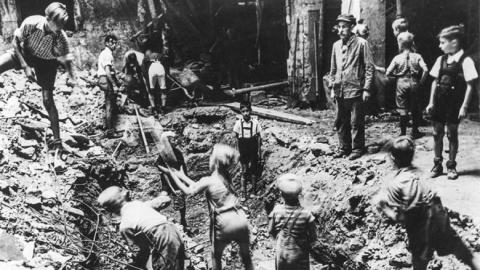
Children clearing the swimming pool at Emma Jaeger's bath house, 1946. There is an Emma-Jaeger-Strasse in Pforzheim.
Aftermath
After the attack, 30,000 traumatized, disoriented people needed to be taken care of, doctored and fed, but there were no facilities to do so. 90% of the buildings in the city center had been destroyed.
One eyewitness recalled: "When at the measuring station the next day I saw the first dead lying. [They were] Terribly mutilated - people who had shrunk like dolls. A mother holding her child still protectively in her arms, both ... half burnt. A nightmare. "...
Many citizens were buried in mass graves at Pforzheim's main cemetery because they were burned beyond recognition. Over the next few days many more Pforzheimers died in pain and agony. Many graves consisted of complete families. The inner city was completely depopulated.
As already stated, further bombing by the US took place until March 24. Was this, too, simply in an effort to even the scoreboard with Stalin? The April 8, 1945 headlines read: "US Seventh Army captures Pforzheim."
Post note from CY: In the 18th century (and presumably before), my maternal grandmother's forebears were living in Bauerbach, a village in the district of Bretten which is only 19 kilometers north of Pforzheim.
This report has been compiled from numerous sources, but principally from this Die Welt article and Exulanten - Hell.
Category
Germany, World War II- 1925 reads







